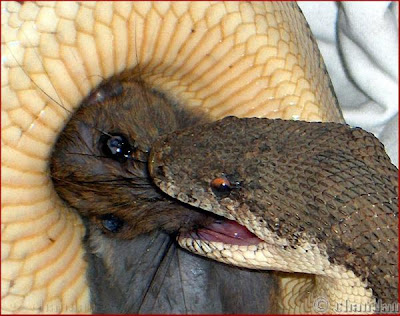Snakes Consuming Large Animals
As the coils wrapped around the animal squeeze ever tighter, so its vital force is sucked out, its eyes glazing over... It's the falling of a final curtain we see all too clearly in the image above, which shows a sand snake with a large rodent of some kind and about to swallow its prey. "One pair of eyes has [a] glitter of joy, the other [the] gloom of death. This is nature unplugged," says photographer, Chandan. We see what he means, yet this prey animal is small by comparison with those that are to follow...Carpet Snake Eating Large Chicken
Here we have an amazing shot of a carpet snake eating a monster-sized chicken. Carpet snakes are approximately 2 meters long. Hanging upside down, the snake will swallow the whole thing. Note how it eats its prey headfirst, as do all constrictors.
Once, it was thought that death by constriction was caused by asphyxia or suffocation, with the snake holding its prey too tightly to allow the prey to take a breath, but new research shows the death comes through different means (and what the snakes don't do is crush their prey to death, as myth would have it).
Diamond Python Eating Ringtail Possum
Researchers noticed that many prey animals died more quickly than would be expected from asphyxia, and some now believe that the constriction may be causing such a great internal rise in pressure that the heart cannot deal with it. The prey dies from quick cardiac arrest in this case.
Python with Spotted Deer
The new hypothesis on how the prey die is still being researched, but one thing scientists do know is that the snakes have the ability to exert enough pressure. The most powerful is the green anaconda, which can apply 4,000kg of pressure with its coils.
The teeth of pythons and other constrictor snakes help to push the prey down the throat, while their muscles move it down to the stomach. It can take days for food to be digested and hours for the snakes to consume the prey when it is large. The python above is gulping down a fully-grown spotted deer in the forests of India's Mudumalai National Park.
Python Coiled Around Impala
This next image might provide some anecdotal evidence in favor of the hypothesis that the prey dies from rising pressure in its body cavity causing a heart attack. As you can see the python's coils are around the impala's lower body, not its ribs.
There have been cases in medical annals of human infants being killed by constrictors, and you can see how it could happen. Fortunately such cases are rare.
Python with Impala
Constrictors show how incredibly strong they are with their ability to kill animals so much larger than they. This last image shows a python that had previously eaten the head of its victim and was now up to the impala's shoulders. "By the next morning," says photographer Tina Owens, "it was gone."
As all these images show, nature can be cruel yet at the same time amazing. It is one thing for a frog to swallow a fly whole, but for these snakes to take larger mammals is one majorly big mouthful.
Python pulling itself over most of an impala's head, the victim's ears still exposed.
Death comes in many forms, but one of the most dramatic and disturbing is the way some snakes constrict their prey. Seeing a hapless impala or goat wrapped in the coils of a beady-eyed reptile, the life draining out of them, seems a terrible way for the animal to die, but new information suggests such a death may actually be quicker than once was thought.
Python Consuming Female Goat
This is an absolutely incredible picture of an African rock python constricting and attempting to swallow a female goat. The python itself is huge, 15 feet long, and may well manage to consume the whole thing.
Snakes that constrict their prey are generally non-venomous. Among them are anacondas, pythons, king snakes, carpet snakes and boa constrictors. If the prey are smaller mammals, the snake strikes and pulls them into its coils; if larger, it pulls itself onto and around the prey.
Boa Constrictor Eating Large Rodent
Boa constrictors like the one pictured here are mostly ambush predators that lie hidden in wait for prey, but they do actively hunt on occasion.
Python and Buck
This 10-foot rock python, again photographed in Africa, is struggling to eat a buck deer. It pulled itself up around the body of the deer over the course of half an hour but in the end regurgitated it all. It seems its eyes were bigger than its belly.
Python and Buck
This 10-foot rock python, again photographed in Africa, is struggling to eat a buck deer. It pulled itself up around the body of the deer over the course of half an hour but in the end regurgitated it all. It seems its eyes were bigger than its belly.









